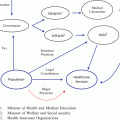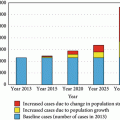Fig. 19.1
Estimated new cancer cases and deaths worldwide for leading cancer sites by level of economic development. Source: GLOBOCAN 2012
The World Health Organization (WHO) projected that by 2030, the cancer figures could increase to 26.4 million new cases and 17 million cancer-related deaths. The majority of the global cancer burden is shifting from the more developed world to economically disadvantaged countries. Nearly 70 % of cancer incidence will occur in economically disadvantaged countries, where survival rates are less than half of those in developed countries. Population growth and aging are the largest contributors to the increasing numbers of cancer cases in low- and middle-income countries. The population aged 65 and over in low- and middle-income countries is expected to increase from 247 million to 982 million between 2000 and 2050, due to increased attention and resources to combat HIV/AIDS and other infectious diseases [2].
The United Arab Emirates (UAE) is a rapidly developing country composed of a multinational population with varying educational backgrounds, religious beliefs, and cultural practices, which pose a challenge for population-based public health strategies. A number of public health issues significantly contribute to morbidity and mortality in the UAE.
The UAE has a highly developed health service, including a sophisticated physical infrastructure of well-equipped hospitals, specialized clinics, and primary care centers. Health care is free for all nationals, and there is a compulsory health insurance scheme in place in Abu Dhabi to cover all residents. The scheme will be extended country-wide.
Currently, there are 65 hospitals in the UAE, 15 of them federal institutions, and over 150 primary health care centers and clinics, in addition to 11 school health centers, 10 centers for mothers and children, and 110 special units for mothers and children in hospitals and primary health care centers. This is compared with 7 hospitals and 12 health centers when the Federation was established in 1971.
Nevertheless, as the population increases and health care demands burgeon, Government policies and strategies, such as Emirates Vision 2021 and the Strategy of the Government of the United Arab Emirates 2011–2013, are committed to make continuing improvements to health care, including remote areas.
UAE Demographics and Population Growth
In Abu Dhabi; one of the seven UAE emirates and the capital; every individual is entitled access to health care and health insurance is mandatory in all emirates, and many elements are being implemented to provide world-class quality health care. Population growth is the product of natural growth and net migration [2]. Migrant workers are recruited from all over the world to satisfy the manpower demands of the fast-paced economic and industrial developments in the UAE [3]. Consequently, the UAE population has increased substantially primarily due to the high inward migration of expatriate workers (4.1 million in 2005, 8.3 million in 2010) [4]. Indeed, mass recruitment of migrant workers has created an unusual population structure; with the total UAE population composed of approximately 11 % (950,000) Emiratis, and the rest are expatriates of varying nationalities [5]. Similarly, the total population of Abu Dhabi (the largest emirate in the UAE) is estimated to be 2.3 million, with over half of the population being expatriate males’ aged 20–59 years [5].
As a result of expatriate workforce recruitment for industrial projects, males outnumber females 3:1 in the overall UAE population (nationals and non-nationals); however, there are approximately equal numbers of male and female UAE nationals. Among non-nationals, the ratio of males to females is 3.7:1 due to the imbalance between the number of expatriate males employed in construction compared with migrant females working in hospitality, health care, or domestic service [2]. As such, the UAE is composed of a multinational population, with varying educational backgrounds, religious beliefs, and cultural practices, which pose a challenge for population-based public health strategies.
In 2013, HAAD has presented estimates of population growth in Abu Dhabi emirates for both the nationals and expatriates as seen in Fig. 19.2.
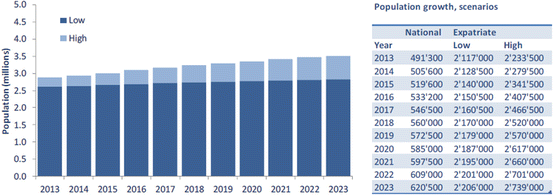

Fig. 19.2
Population estimates here are based on raw insurance data; projections are rounded to the nearest 2.5 % variance between high and low, and those for expatriates at 5 %. Source: Health Statistics 2013; HAAD (Health Authority—Abu Dhabi)
Cancer Status in UAE
Cancer is the second leading cause of death worldwide and in all regions of the world. Historically, the UAE had a much lower incidence of cancer than Western countries; however, over the last 40 years, it has undergone a period of dramatic economic, social, and demographic change, resulting in increased life expectancy and prosperity. This epidemiological transition has led to significant increases in the incidence of all chronic noncommunicable diseases, including cancer, which is now the third leading cause of death in the UAE (after cardiovascular disease and injury) causing 10 % of all deaths in 2010 and 16 % of all deaths in the emirate of Abu Dhabi during the same year [6]. At present, there is no national or regional population-based cancer registry in the UAE, which means there is no reliable information available on the incidence of cancer in the UAE. However, the Ministry of Health collected some cancer registration data for the UAE, which has been submitted for inclusion in the Globocan database [7] and Gulf Cooperation Council-wide cancer registry report, “Ten Year Cancer Incidence Among Nationals of the GCC States 1998–2007,” published by the Gulf Centre for Cancer Registration [8].
The Globocan data from 2008 shows that the age-standardized rates for the incidence and mortality from all cancers in the UAE is lower compared to Western countries, such as the United States (Table 19.1). The incidence of all cancers is projected to double by 2020, primarily due to aging and also possibly due to increased exposure to risk factors for cancer. Breast cancer is the most common cancer among Emirati females, lung cancer is the most common cancer among Emirati males but is extremely rare in females, which reflects the prevalence of smoking (23.0 % vs. 0.5 %, respectively), and colorectal cancer is the second most common cancer in both sexes combined (Table 19.2) [7–9]. However, rates for all three types of cancer are much lower than most Western countries and are also lower than in Qatar, Bahrain, and Kuwait [13]. This is likely to be due to the younger age of the population, less exposure to some risk factors, lower levels of screening compared to Western countries, and possibly incomplete registration. Cancer rates are also projected to increase by the year 2030 as the UAE population ages, total fertility declines, exposure time to lifestyle risk factors increases, the prevalence of obesity and diabetes increases, and due to the long latency period between starting smoking and developing lung cancer. Population-based education and awareness campaigns are urgently required to increase screening rates for at-risk individuals and to facilitate early diagnosis and prompt treatment, thereby reducing morbidity and improving survival.
Table 19.1
Summary of age standardized incidence and mortality rates from cancer in males and females in the UAE and US 2012
United Arab Emirates | USA | |||||
|---|---|---|---|---|---|---|
Male | Female | Both sexes | Male | Female | Both sexes | |
Population (thousands) | 5619 | 2486 | 8105 | 156,002 | 159,788 | 315,791 |
Number of new cancer cases (thousands) | 1.5 | 1.4 | 2.9 | 824.7 | 778.9 | 1603.6 |
Age-standardized rate (W) | 83.8 | 127.2 | 92.5 | 347.0 | 297.4 | 318.0 |
Risk of getting cancer before age 75 (%) | 9.1 | 13.6 | 10.2 | 34.1 | 28.5 | 31.1 |
Number of cancer deaths (thousands) | 0.7 | 0.5 | 1.3 | 323.9 | 293.4 | 617.2 |
Age-standardized rate (W) | 57.9 | 64.9 | 58.0 | 123.9 | 91.7 | 105.8 |
Risk of dying from cancer before age 75 (%) | 6.0 | 7.2 | 6.3 | 12.8 | 9.8 | 11.2 |
5 years prevalent cases, adult population (thousands) | 3.9 | 5.0 | 8.8 | 2402.2 | 2373.0 | 4775.2 |
Proportion (per 100,000) | 78.6 | 271.4 | 131.1 | 1943.9 | 1842.5 | 1892.1 |
Table 19.2
Five most frequent cancers by gender in the UAE and US 2012
Ranking | United Arab Emirates | USA | ||||
|---|---|---|---|---|---|---|
Male | Female | Both sexes | Male | Female | Both sexes | |
1 | Colorectum | Breast | Breast | Prostate | Breast | Prostate |
2 | Lung | Thyroid | Colorectum | Lung | Lung | Breast |
3 | Non-Hodgkin lymphoma | Cervix uteri | Leukaemia | Colorectum | Colorectum | Lung |
4 | Leukaemia | Colorectum | Lung | Bladder | Corpus uteri | Colorectum |
5 | Prostate | Ovary | Non-Hodgkin lymphoma | Melanoma of skin | Thyroid | Melanoma of skin |
In 2009, UAE’s population stood at about 5.7 million, of which approximately 21.9 % were nationals and the rest foreigners. As a consequence, UAE nationals form a minority of those who reside in the country. UAE has one of the most diverse populations in the Middle East. 23 % of the population is non-Emirati Arabs or Persians and the majority of the population, about 50 %, is from South Asia.
The population of the UAE also has a skewed sex distribution consisting of more than twice as many males as females. The 15–65 age groups have a male/female sex ratio of 2.743. The average life expectancy is 78.24 years, higher than any other Arab country. The breast cancer in UAE is considered the number one cancer among females and constitutes almost 23 % of all cancer cases and 43 % of all female cancers annually and that is similar to international ratios.
Cancer rates are set to increase at an alarming rate globally as well as locally. Cancer is set to become the fifth disease in UAE and GCC region. A difference can be made by taking action today and use the opportunity to stem this increase. Governments, health practitioners, and the general public need to take urgent action; actions as cost-effective treatment plans, provision of financial support to people, screening awareness, and tobacco cessation (see Figs. 19.3 and 19.4).
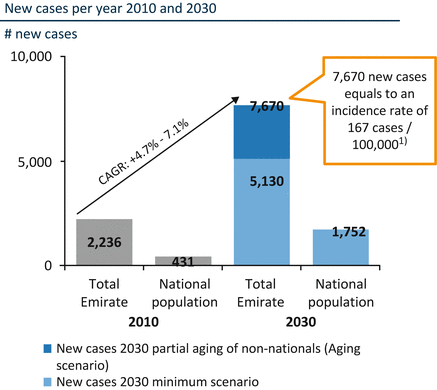
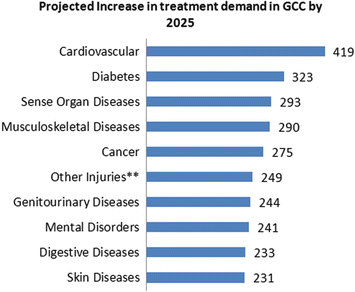

Fig. 19.3
Estimated projection of new cancer cases in UAE amongst national and expatriates based on population growth and market labor needs

Fig. 19.4
Projected level of cancer cases in the UAE and GCC countries showing cancer cases are increasing at an alarming rate. Source: McKinsey & Company
Age-standardized rate (W): A rate is the number of new cases or deaths per 100.000 persons per year. An age-standardized rate is the rate that a population would have, if it had a standard age structure. Standardization is necessary when comparing several populations that differ with respect to age because age has a powerful influence on the risk of cancer. Risk of getting or dying from the disease before age 75 %: The probability or risk of individuals developing dying from cancer. It is expressed as the number of new born children (out of 100) who would be expected to develop die from cancer before the age of 75. If they had cancer rates observed in the period in the absence of other causes of death.
Uptake of Oncology Drugs Costs on Selected Cancers in UAE
UAE hospitals are not unique in the struggle to coping with the existing and further increasing financial burden caused by cancer and its treatment. Worldwide, drugs associated with cancer care are estimated to cost approximately $40 billion per year. In the United States, cancer drugs represent the biggest category of overall pharmaceutical sales, in 2007 sales increased by 14 %. Seventy percent of these sales came from products introduced in the last 10 years and 30 % in the last 5 years [10]. These new drugs have improved the quality of life, delayed disease progression, and helped prolong survival for patients.
New molecular targeted agents introduced in recent years include well-known agents such as Rituximab (1997), Trastuzumab (Herceptin in 1998), Imatinib (Gleevec in 2001), and Bevacizumab (Avastin in 2004) therapies that caused excitement among the oncology community. However, such therapy comes at considerable cost, just recently new agents were released such as Regarofenib (2012) and Pertuzumab (2012) and we know that there are many other new agents under development.
It is widely recognized that the across tumor sites, mean net costs of care are highest in the initial and last year of life phases of care and lowest in the continuing phase [11, 12].
The significant increase in costs of initial cancer treatment reflects more patients receiving surgery and adjuvant therapy and rising prices for these treatments. These trends are likely to continue in the near future, although more efficient targeting of costly therapies could mitigate the overall economic impact of this trend [13].
The costs of cancer care are substantial and vary by tumor site, phase of care, stage at diagnosis, and survival.
Patterns of care have been reported to be more aggressive for younger cancer patients compared with elderly cancer patients in many health care settings. In addition, as the prevalence of comorbid conditions and levels of medical care increase with age, health care spending also typically increases with age [14].
Oncologists are in a difficult position, on the one hand, as prescribers they can be asked to be gatekeepers; on the other, they are advocates for their patients. These issues are well recognized in the oncology community and as such organizations such as ASCO through their Journal of Clinical Oncology publish many studies on economic evaluation [15].
Cancer caused 14 % of all deaths in the Emirate of Abu Dhabi in 2011. Lymphoid, hematopoietic, and related tissue cancers are the dominant cancers in Abu Dhabi. Late detection of breast cancer leads to significant increases in mortality. Female adult nationals aged 40–69 are being screened for breast cancer as part of their Thiqa insurance renewal. Education and awareness campaigns have increased screening rates for all nationalities [16].
The American Society of Clinical Oncologists (ASCO) issued a guidance statement affirming the “critical role of oncologists in addressing costs of care.” Since in the United States the high cost of cancer care can be financially devastating to patients and their families, oncologist communicate with their patients and discuss costs of their therapy and implications on the quality of care [17].
Outside of the United States, many counties use a formal process to evaluate new technologies before deciding whether they should be broadly adopted.
Published estimates for the treatment costs of breast cancer vary widely in methodology, perspective, patient populations, and time horizon.
Breast cancer represents the most drug-intensive area when it comes to treatment of solid tumors. Tamoxifen, a costly treatment launched in 1975 has established itself as the most cost-effective cancer treatment to date. Its broad indication for the treatment of advanced disease and adjuvant treatment represents a major breakthrough in the treatment of breast cancer. Newer, innovative drugs (aromatase inhibitors; anastrozole, exemestane, and letrozole) are now replacing, fully or in part, tamoxifen, both in the treatment of advanced disease but also in the adjuvant setting. In addition, anthracyclines and taxanes have established themselves as very valuable palliative and adjuvant treatments.
Trastuzumab, an HER2 receptor antibody, has become a cornerstone of treatment for patients with advanced breast cancer over-expressing HER2, in the adjuvant setting.
The lifetime treatment Estimates per-patient costs of breast cancer ranged from US$ 20,000 to US$ 100,000. (Campbell and Ramsey 2009) [18]. While disease stages I and II were emphasized, the costs of initial and terminal therapy were greater than continuing care on a per unit time basis, but continuing care accounts for the largest share of lifetime cost due to the relatively long survival of breast cancer patients.
Costs of different surgeries were relatively similar (breast-conserving surgery vs mastectomy) but, all else equal, significant costs (US$ 23,000–31,000) were observed for patients who received adjuvant chemotherapy compared with those who did not.
In the 1980s, colorectal cancer remained a therapeutic area in which medical treatment was considered to have little or no effect. Developments in diagnostic and surgical techniques were major contributors to outcome improvement. With the publication of the adjuvant data on modulated 5-fluorouracil (S-FU)-based therapy, colorectal cancer rapidly became an area of focus for further drug development. Recently, two new innovative drugs, Bevacizumab and cetuximab, have also been used for the treatment of advanced colorectal cancer; representing a more cost incurred in the treatment of the disease. Bevacizumab is an anti-angiogenesis drug with its indication in the first-line treatment of advanced colorectal cancer. Cetuximab , which interacts with the epidermal growth factor (EGF) receptor, is indicated in the second or third-line treatment of metastatic disease. The prevalence of colorectal cancer was projected by Mariatto et al. (2006) [19] to increase in the United States from 1,002,786 (0.36 %) patients to 1,522,348 (0.46 %) patients between 2000 and 2020. Their review of SEER data they project that colorectal cancer prevalence will increase more rapidly than the US population, largely due to the aging of the US population. This suggests that considerable resources will be needed in the future for initial, continuing and last year of life treatment of colorectal cancer patients unless notable breakthroughs in primary prevention occur in the future years.
Oncology drugs account for a significant proportion of drug expenditures in the clinic setting in the United States (Hoffman et al. 2012) [20].
Stay updated, free articles. Join our Telegram channel

Full access? Get Clinical Tree



